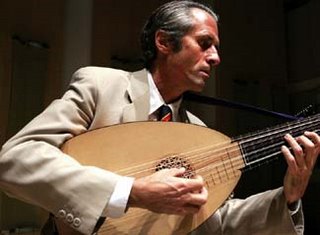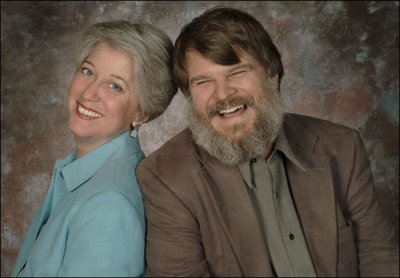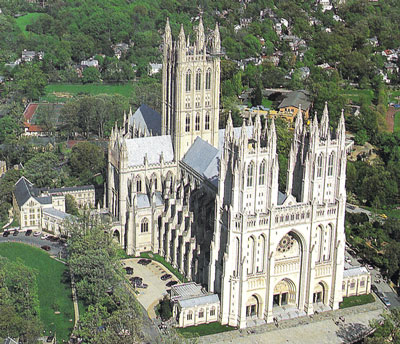 The Friends of Music concert series at Dumbarton Oaks offers a little banquet for the ears of its small group of subscribers once a month. Last night, it was lutenist Hopkinson Smith, who played a program of solo lute music by Francesco da Milano (1497-1543) and John Dowland (1563-1626). The normal venue for this excellent series, the Music Room, has been closed during the renovations of the Georgetown estate of Mildred and Robert Bliss, but the temporary digs in the refectory of the one-time Director's House are intimate and lovely. Seated a few feet from the warm bodies of the audience and in front of a drafty pair of French doors, tuning was, as Smith admitted, an issue. As a result, he tuned extensively between each set, often improvising or playing brief sections of the next piece on his stand. The results were excellent listening indeed.
The Friends of Music concert series at Dumbarton Oaks offers a little banquet for the ears of its small group of subscribers once a month. Last night, it was lutenist Hopkinson Smith, who played a program of solo lute music by Francesco da Milano (1497-1543) and John Dowland (1563-1626). The normal venue for this excellent series, the Music Room, has been closed during the renovations of the Georgetown estate of Mildred and Robert Bliss, but the temporary digs in the refectory of the one-time Director's House are intimate and lovely. Seated a few feet from the warm bodies of the audience and in front of a drafty pair of French doors, tuning was, as Smith admitted, an issue. As a result, he tuned extensively between each set, often improvising or playing brief sections of the next piece on his stand. The results were excellent listening indeed.
Smith may be the most famous lutenist in the world, if such a title is even relevant, having been a celebrated teacher at the Schola Cantorum Basiliensis in Basel and having played far and wide, even on NPR (you can hear him playing pieces by Luis Milan at their Web site). However, now that Edin Karamazov has made an album with Sting, Smith may have to take second place. Much like the lute itself, Smith's performing demeanor was understated and gentle, a slight form in a tan suit, gray-tinged hair, and professorial spectacles. The lute's sound is so delicate, almost spectral, but when played well it can sound two, three, or four contrapuntal voices quite distinctly: at one point, Smith used the thumb of his right hand to pluck out a bass melody on the lower strings under higher chords. However, if you push the sound too hard, the lute will growl or sound scratchy, but with Smith that happens very rarely.
In a low-key didactic mode, Smith gave wry, thoughtful program notes before most of the sets of pieces. The program featured music by Dowland, mostly dance forms made into character pieces describing people in the composer's life, works that Smith has recently recorded for his 2005 Dowland CD. He is probably tired of people asking him about how Sting "discovered" John Dowland, but actually Sting's Dowland CD paired with Smith's would make a very nice Christmas present. Highlights included the sweet, dancelike, triple-meter
Mrs. White's Nothing, the gorgeous
Pavin la Mia Barbara (made while Dowland was working in Germany, named for an unknown Barbara, and notated only in a German manuscript), and the galliard in honor of
The Most High and Mightie Christianus the Fourth King of Denmarke (composed during Dowland's stay in Denmark). Smith informed us that he played versions of the famous
Lachrimae Pavin and
Lady Hunsdon's Allemande from an appropriate source, the
Dowland Lute Book, a manuscript now conserved in Washington's own
Folger Shakespeare Library.
Providing a contrast to the more proto-tonal harmony of Dowland's music were selections, mostly fantasias and a few dance pieces, by Francesco da Milano, lutenist at the papal court in Rome. Although Francesco died only 20 years before Dowland was born, his music sounds much more modal in character, and he preferred to write down mostly his more serious and abstract fantasias. Hopkinson Smith has attempted to recreate some sense of Francesco's lauded improvisations on dance themes, pieces he called self-deprecatingly, "my own kind of concoction -- composition would be too good a word." Of special interest were the
Fantasia no. 40 dal sesto tono, a fast and quirky exercise in contrapuntal imitation, and the melancholy
Fantasia no. 33 sopra mi-fa-mi, in which that simple half-step theme (mi-fa-mi) is woven into a complex and enigmatic puzzle. As far as I can determine, Smith has not made a Francesco recording, but on the basis of these performances, I hope he does soon.
This program will be repeated this evening (November 4, 8 pm) and Sunday evening (November 5, 7 pm). Hopkinson Smith has two more concert appearances scheduled this month in the United States -- Pittsburgh State University in Pittsburgh, Kans. (November 9) and Brisbane, Calif. (November 11 and 12). The next concert on the Friends of Music series at Dumbarton Oaks will feature the Turtle Island String Quartet in the December Solstice Concert on December 8, 9, and 10.





































































